After your decision to visit Ecuador (see Intro to Ecuador), one of the first questions you could ask yourself is: Visit Quito, Yes or No?
A logical question, Quito being the capital of Ecuador. Generally a spot where one expects many special attractions. Things to do you won’t find anywhere else in the country.
As most flights arrive at Quito Airport the capital of Ecuador automatically serves as a gateway to and from your home country. Or, from any other travel destination for that matter.
So no surprise that guests of our hotel in Otavalo – Hotel Doña Esther – ask us regularly about the capital, before they decide to visit Quito, Yes or No?

However, to be able to answer that question, first you have to know where I’m talking about.
- Throughout most posts on this travel blog you’ll find affiliated links provided by TravelPayOuts & GetYourGuide. Links & Ads that may help you plan your next trip to Ecuador. If you click on them & buy a ticket for a museum, book a tour, a hotel or flight a small commission of your purchase will go to me (paid by the platform, and – most importantly – not by you).
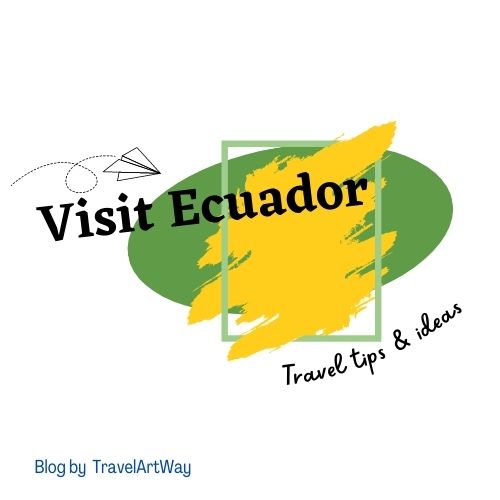
Introduction to a visit to Quito
Quito is located just south of the Equator. High up in the Andes (altitude 2800m/ 9.186ft). Something you’ll generally notice right away when you visit Quito.
- The location of the country’s capital near the Equator is unique. It was one of the main reasons Quito received a special visit in the first half of the 18th century.
- In 1736 a French scientific mission arrived in Ecuador. Using the area around Quito & the Equator as a starting point to “Measure the Earth”. That is, literally measuring the Earth. A historic visit, that left the country – among other things – its name. (For more info, go to: How Ecuador got its name.)

Quito has a long history. Long before the Inca & Spanish invasions it was an important trading post in the region. Better said, between regions – between the Andean highlands, the Amazon to the east & the tropical Pacific coast to the west.
After the Incas conquered the region – in the second half of the 15th century – they made Quito the northern capital of their Empire, the Tihuantisuyo. Supposedly, because the location looked very similar to Cuzco, the main Inca capital in nowadays Southern Peru.
After the Spanish conquest – in the first half of the 16th century – Quito became the capital of the northern province of the Viceroyalty of Peru. A province that was called the Audiencia de Quito.
Long lost past?
When you travel through the capital nowadays, there’s little to remind you of that long past. That is… until you reach the colonial part of Quito.
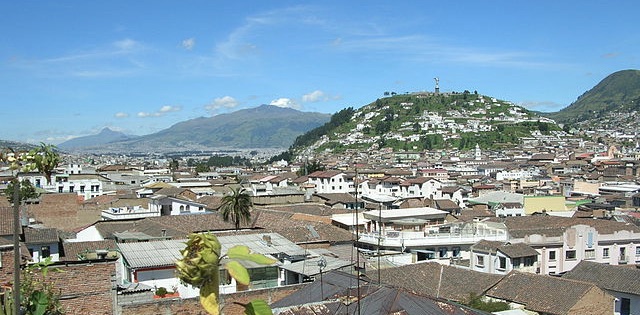
- Historically Quito grew only in a north-south direction. The main reason being bordered by Mt. Pichincha (4.776m/ 15.670ft) to the west & an enormous valley to the east.
- Meanwhile though quite a few people crept up the flanks of the Pichincha to build their homes. While others – generally a-better-off-segment of the population – headed down to the green valley. Through the years causing a daily entry of thousands upon thousands of cars & buses, bringing people to their schools & work.
- The growth eastward in 1993 resulted in the creation of El Distrito Metropolitano de Quito. A district that besides Quito occupies a big chunk of the valley (total population: almost three million people).
Quito’s main attractions
Quito is basically a BIG city. Not interesting at all. Chaotic & even ugly in many parts. However, this opinion dissolves when you enter the Colonial part of Quito. Absolutely worth a visit. A special spot where past & present come together.
It’s really too much to name all the specific attractions in the colonial part, but I will name a few. Personal favourites, but also regularly mentioned by our guests as the # Top Things to Do in Quito.
A visit to the bustling Colonial Center of Quito
The main attraction of the Colonial center is its lively character. Something you have to take in as a whole. The historical buildings, the plazas or squares, the presidential seat, the many churches, the little shops, the restaurants & cafeterias.
As well as people of all walks of life, the busy traffic (too many taxis), the informal vendors that generally sell nothing you can use (…or maybe so). Enjoyable! Just take your time wandering around, and lose yourself.
- WARNING! Where there are lots of people, you’ll always find petty criminals. Be it NY, London, Paris or Amsterdam. Mainly pickpockets. So, watch your stuff. Only bring the things you really need on your visit to Colonial Quito.
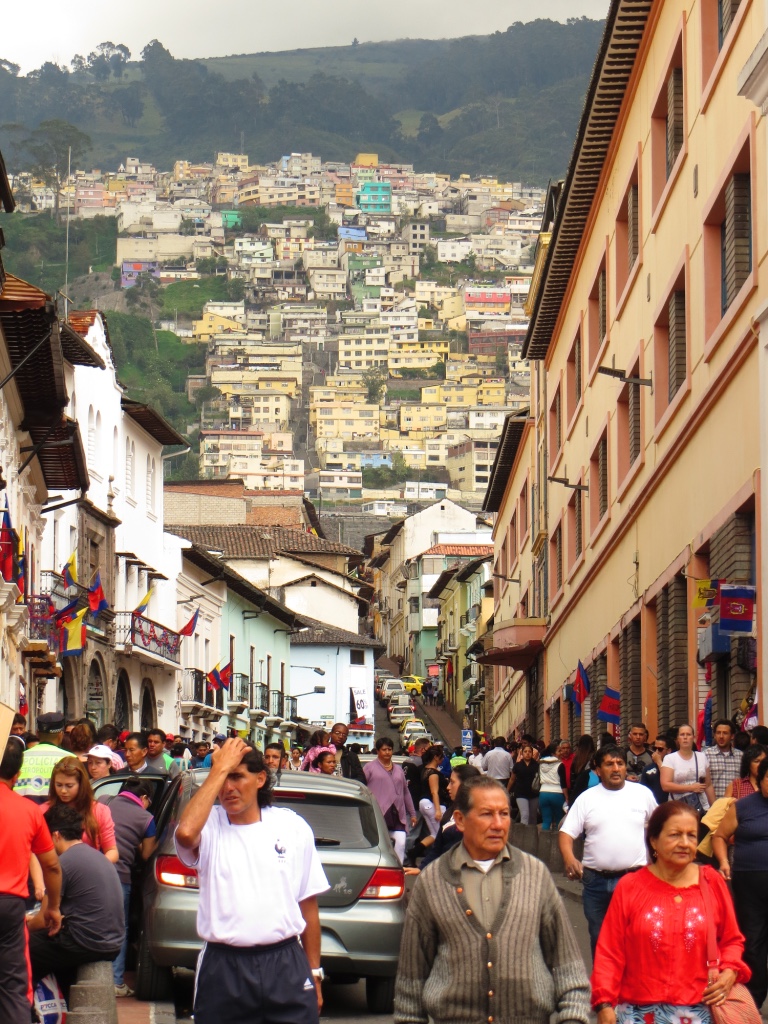
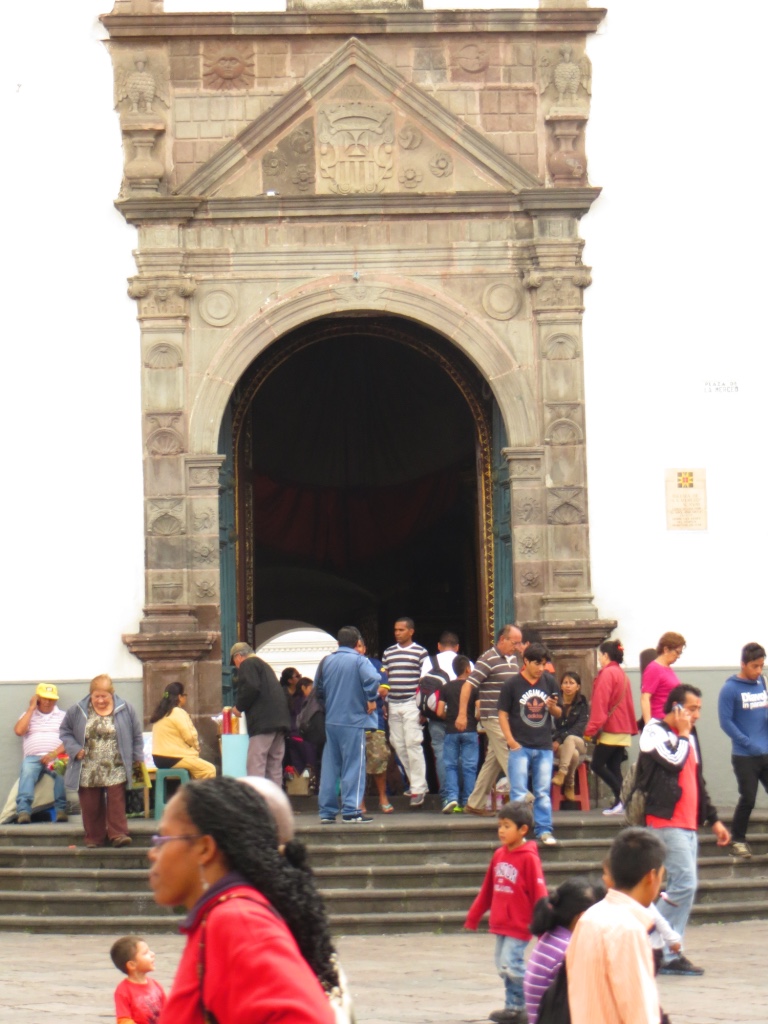
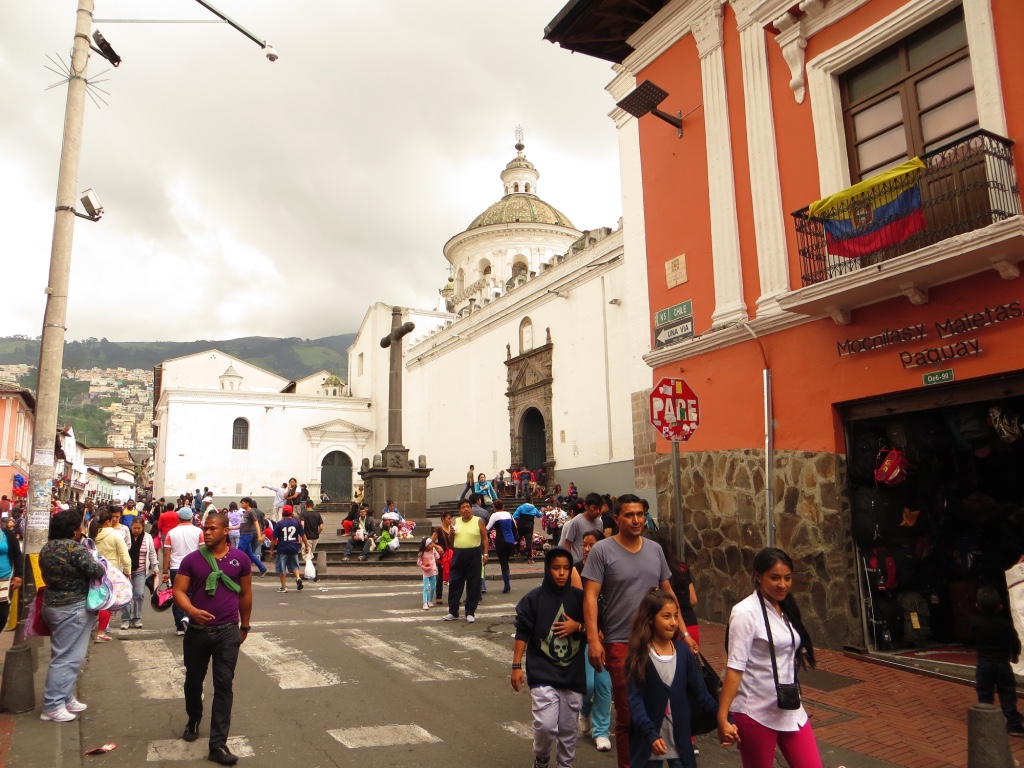
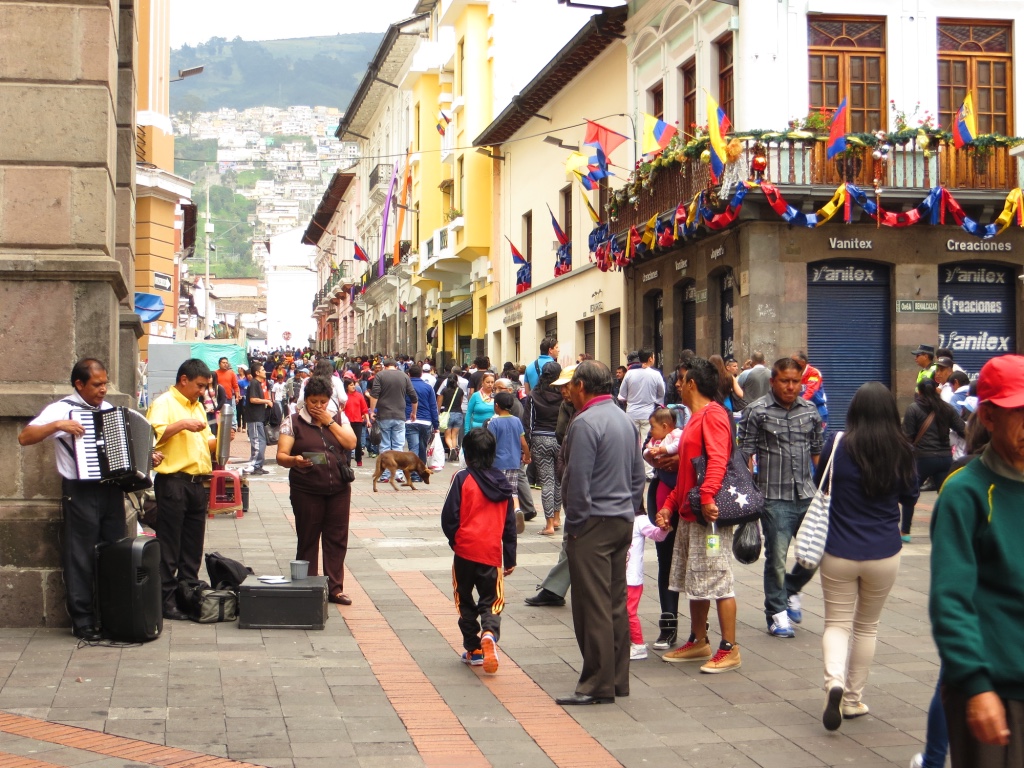
- We call it the “Colonial” center, but – as mentioned above – the history of Quito goes way back in time. Something you’ll still notice, when – for example – observing the base construction of some of the major buildings.
- Like the big stones in the lower part of the Presidential palace & the San Francisco Church. Which actually are remains of the Inca-lord Huayna Cápac and his son Atahualpa.
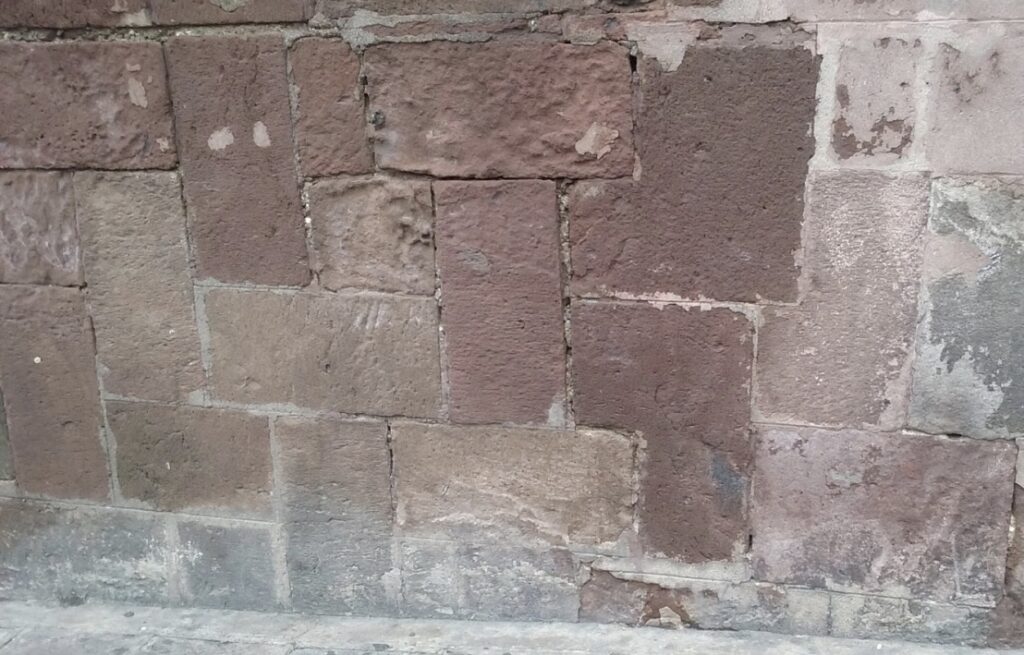
- TRAVEL TIP: When I first arrived in Ecuador (1990) most tourists stayed in the modern neighbourhood El Mariscal. Nowadays though, the majority stays in the Colonial center. Something we also recommend to our own guests.
Religious gems
Quito is known as the main religious catholic center of South America.
In the past many monastic orders settled in the capital. Like the Franciscans, the Dominicans, the Jesuits, the Carmelites… and many more. All with their own churches, monasteries, often schools and hospitals. The one more impressive than the other.
On your visit to Quito Colonial, it doesn’t take long before you get this religious fact confirmed.
Most churches are open to the public, but visiting them all, is maybe too much. Too pious, if you like.
A MUST SEE though is the Iglesia de la Compañía de Jesús. The church of the Jesuits. Magically beautiful. Also for people from other religions or ones who aren’t religious at all.
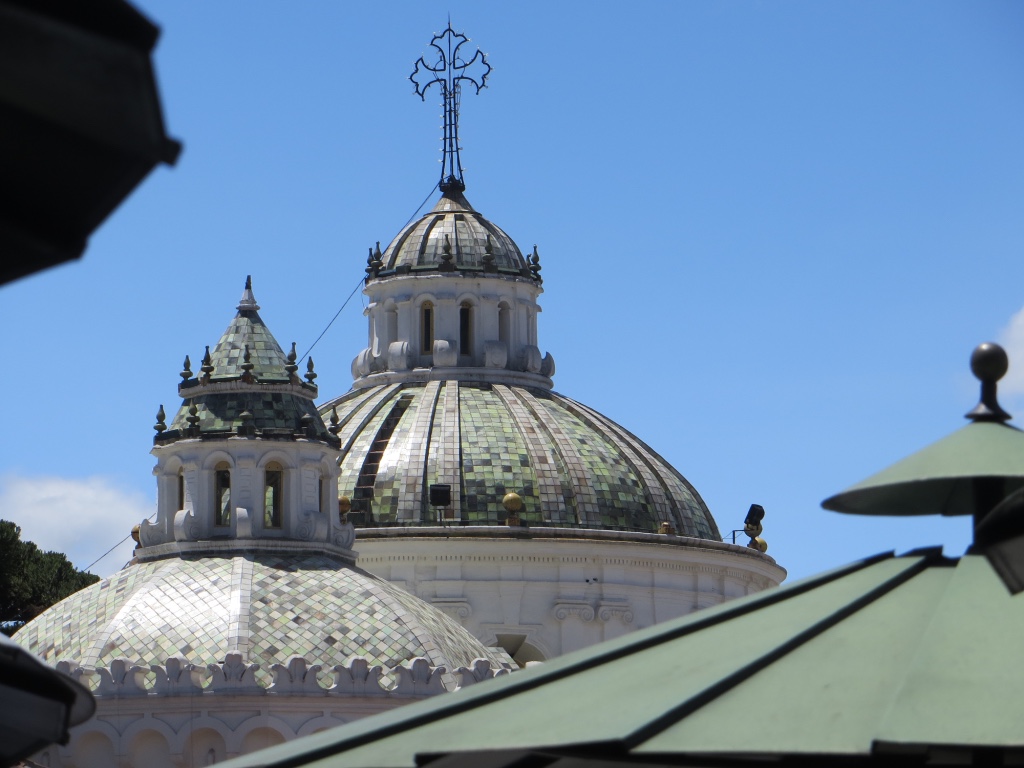
- When I first visited La Compañía for the first time in 1990 I couldn’t see three meters in front of me. The interior was pitch-dark. It felt cold, humid & was smelly. The church obviously needed a thorough restoration, which it fortunately received some years later.
- A transformation that leaves every contemporary visitor flabbergasted. A total metamorphosis, cast in gold. Bright, yellow gold in every crack & corner. Another indication for the riches of the Jesuit church, and the American colonies of Spain.
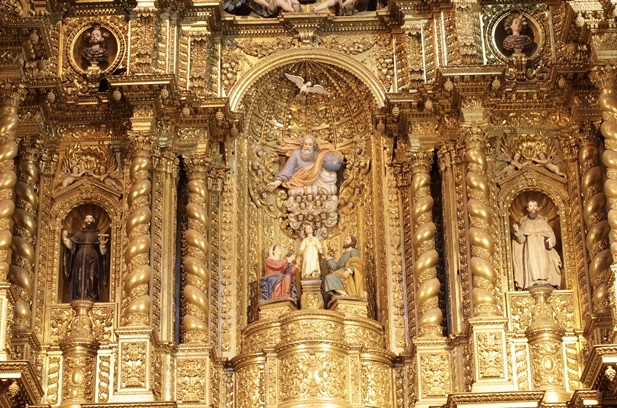
Another church I can highly recommend is the Iglesia y Convento de San Francisco on the Plaza de San Francisco. The oldest church built in Quito. An inside and outside attraction, with its own museum.
Besides these two religious gems, there are many other churches in the colonial part of Quito. Places you can visit on your way through town. Most open daily. Just walk in, to get an idea.
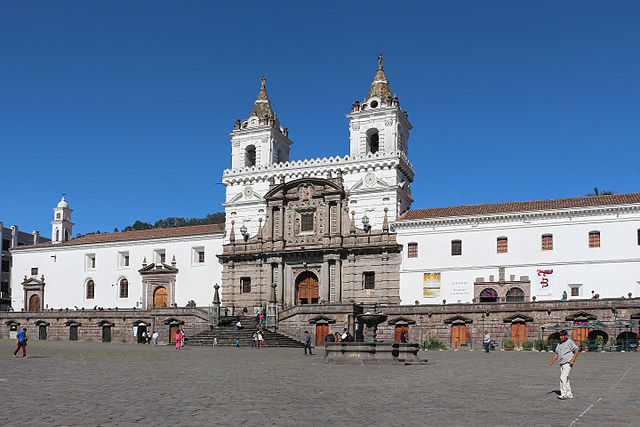
Interesting Museums to visit in Quito
There are several museums to visit in the colonial part of Quito. Most open daily, except Mondays.
Personally, I like the Museo Casa de Sucre, where the liberator of Quito/Ecuador lived, Mariscal José Antonio de Sucre (1795-1830). The man who surprised the Spaniards in Quito on 24 May 1822, crossing over the flanks of Mt. Pichincha the night before. For that reason, this battle is known as the Batalla de Pichincha. Still commemorated every year.
To get an idea of daily life in Quito through the ages, visit the Museo de la Ciudad. Located in a beautiful, renovated colonial building. Besides the main exhibition, at regular times there are temporary ones.
The Plaza Grande or Plaza de Independencia
The Central square of Quito is – typically Spanish – surrounded by the main political & religious buildings of that place.
Here you’ll find – being the capital of the Republic of Ecuador – the Palacio de Carondelet, where the President resides. If lucky, you can catch a glimpse of him. Or else, when you enter the Palace on a free guided tour (Daily, accept Mondays – bring your passport).
- At the time of publishing this blog post the President is Guillermo Lasso Mendoza (2021-2025, center right), who replaced President Lenin Moreno in 2021 (center left).
Directly across from the Palace, you’ll find the Mayor’s office. The least interesting building around the main square. Although there’s a nice Souvenirs shop at the right corner of the building.
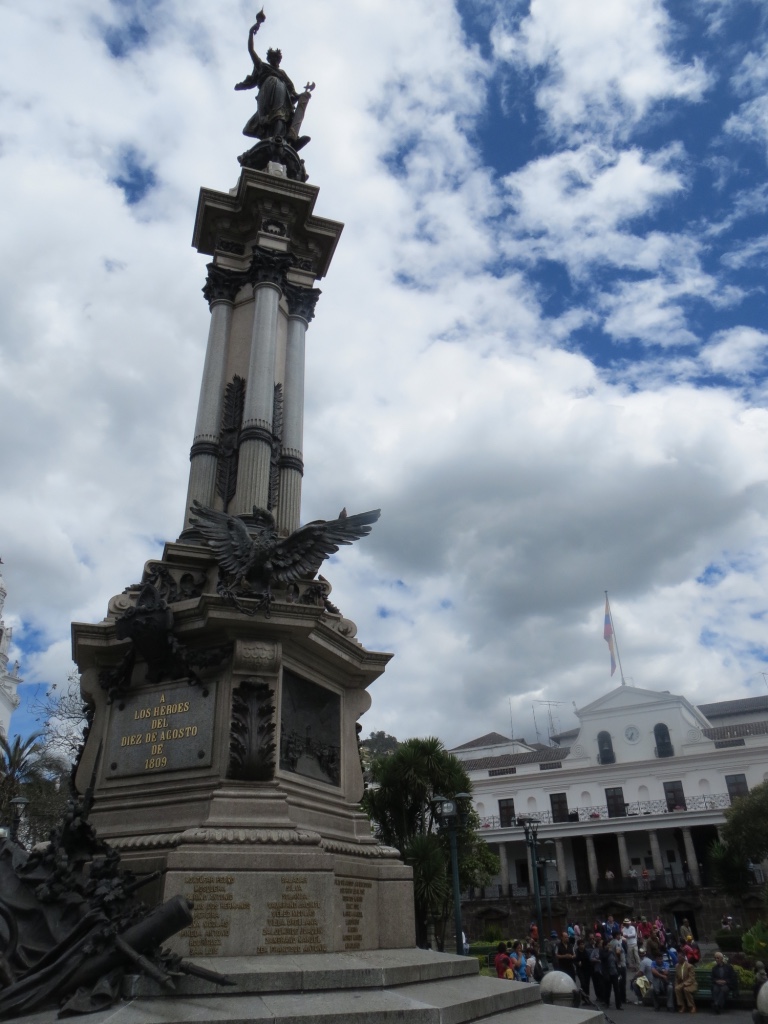
On the South side is located the Catedral de Quito or Catedral Metropolitana. Another religious attraction, but also a political one because several political protagonists found their ultimate resting place there. Like the earlier mentioned liberator José Antonio de Sucre. As well as one of the best known former presidents of Ecuador, the conservative President Gabriel García Moreno (1821-1875). Murdered nearby (with a machete) while still in office.
Across from the Catedral – to the right – you’ll find the Palace of the Archbishop of Quito. A beautiful place to visit, full of little (souvenir) shops, patios, cafeterias & restaurants.
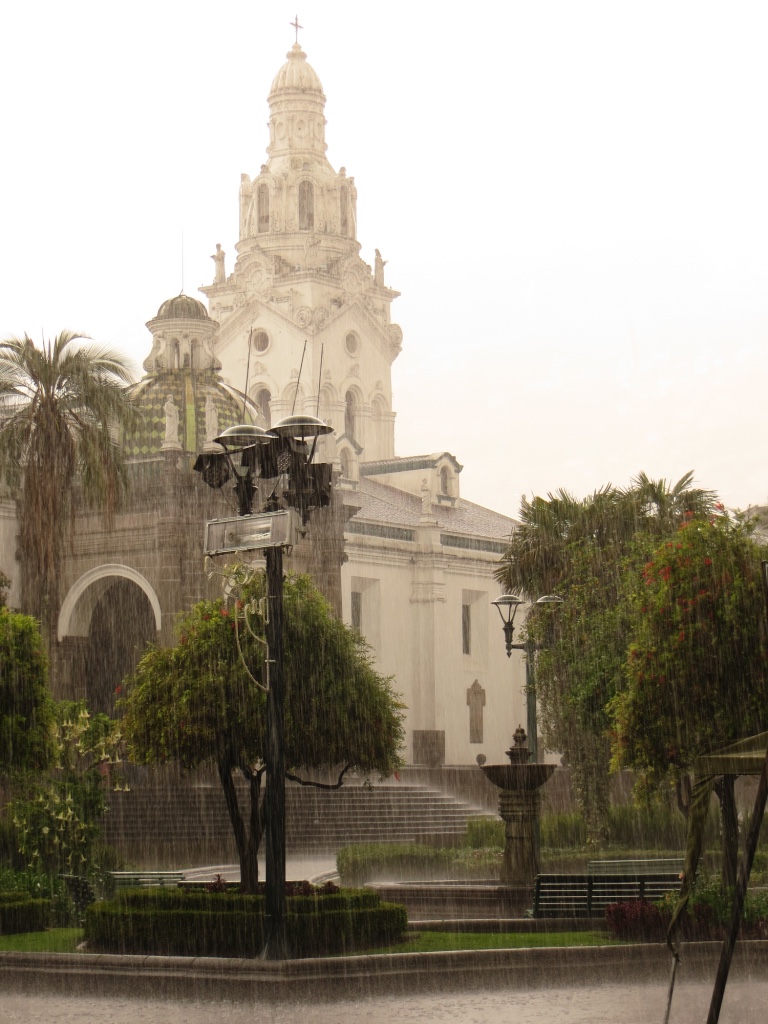
Calle La Ronda
Another area that’s worth a visit while in Quito colonial is La Ronda Street. A street that takes you back in time. Thoroughly renovated, full of little shops, bars & restaurants. It’s the best place to feel the Quito of the Past.
I can tell you about it, but you better have a look yourself. You won’t be disappointed.
Virgin del Panecillo
Also highly recommended is a visit to the Panecillo Hill (meaning the “little bun” hill). Mainly for the magnificent view you’ll get over the city. Not only over the impressive Colonial center of Quito, but also its surrounding area.
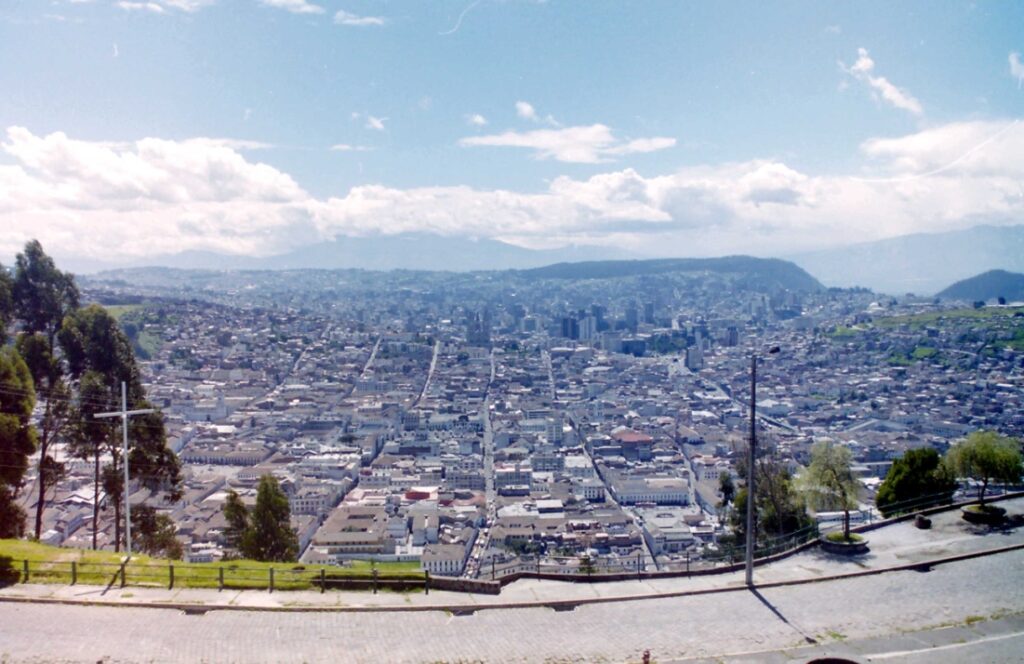
the more modern Northern part of the elongated city.
- As you can see in the picture above, from the center Quito stretches out northward as far as the eye can see. The same happens when, on the Panecillo, you turn your back southward.
- The southern trench is generally known as the more popular or working class part of Quito. An area where seldom a tourist goes. It has its own vibe though. Parks & historical attractions, like the impressive colonial Ministry of Defence or the Chimbacalle train station(both not too far from the Panecillo).
On the hill itself you’ll find the enormous statue of the Virgín de Quito. A statue (41m/ 135ft) you can climb, if you like to have a slightly higher viewpoint over Quito.
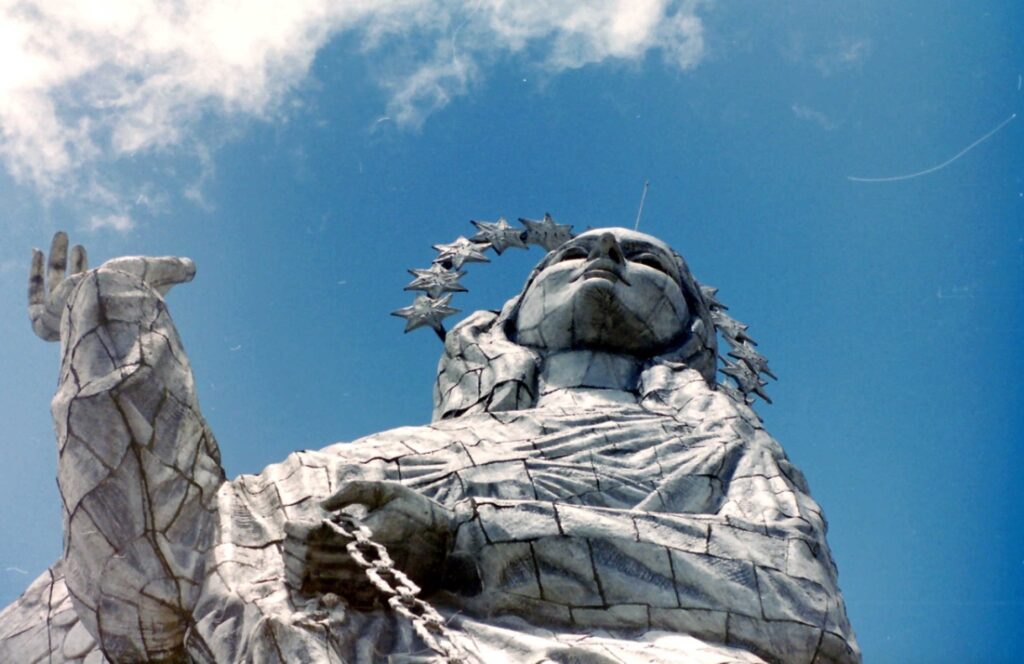
- To get to the Panecillo, take a taxi! It’s a steep climb up from the Colonial Center. And besides that – although the center got safer through the years – some unfortunate visitors got robbed recently on their way up.

Other attractions to visit in Quito, outside the Colonial center
Parque La Alameda
La Alameda is the oldest park in Quito, dating from 1596.
Through the years it has kept its somewhat old-fashioned colonial style. It’s a small park, but worth a visit when you’re in the neighborhood. Prominently in its middle, the Observatory.
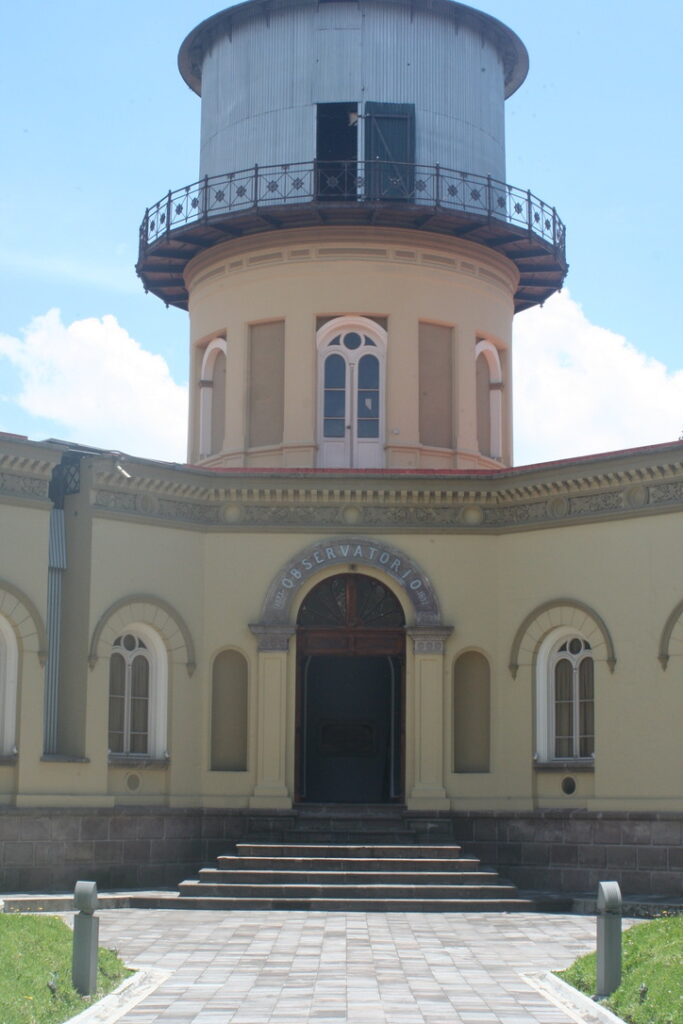
The Quito Astronomical Observatory was built in 1864. The first one in South America. Also worth a visit. Periodically still operative, but nowadays formerly a museum.
A museum, closely connected to the fact that Ecuador is located central on our Earthly globe.
- As told before, the presence of the Equator was the reason why French scientists visited the country in the 18th century. An interesting story. For me personally soo interesting that I wrote a book about it. In Dutch, I’m afraid, but fortunately – for those people interested – I also wrote some blog posts about it. Go to: French Geodesic mission.
When the capital started growing, soon the Alameda wasn’t big enough anymore. This resulted in a new park every now & then. Something you immediately notice looking at Quito’s map. Considering only the northern part of town, you’ll notice – after the Alameda of course:
- The Parque El Ejido (1922), where’s there’s a daily art & souvenir market
- The Parque La Carolina (1976), with its beautiful Quito Botanical Garden, also worth a visit
- And finally the Parque Bicentenario de Quito (2013), located on the spot where the former airport was.
Museo Nacional/ Casa de las Culturas Ecuatoriana (CCE)
For the history buff: bring a visit to the National History museum in the Casa de las Culturas of Quito. Located near the El Ejido Park & the Mariscal neighbourhood. Recently renewed, it provides a good overview of Ecuador’s earliest history. A long history which may surprise you.
- Besides the Historical museum, the Casa de las Culturas houses several other museums. Like one on Ecuador’s Ethnography & another on Modern Art & Musical Instruments. This, besides temporary exhibitions around specific themes.
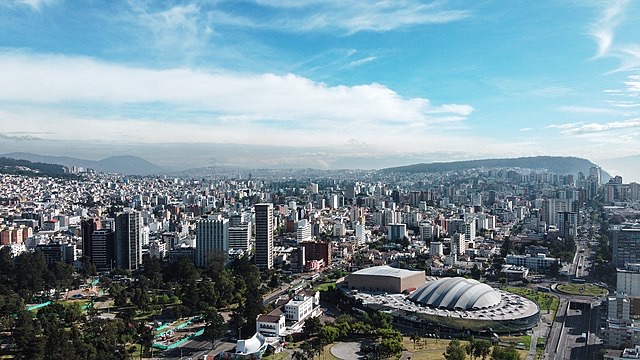
- For more info, go to: Casa de las Culturas.
TelefériQo
Feel like a Condor. High above Quito, on the flanks of Mt. Pichincha (4.680m/ 15.354ft). The TelefériQo cable car takes you up in about 15 minutes to Cruz Loma (4100m/ 13.451ft).
From that point, you can enjoy amazing views of Quito & its surroundings. And if you’re lucky, you’ll see some of the snow-capped volcanoes that characterise the Ecuadorian highlands, like the Cotopaxi (5.897m/ 19.347ft) to the South or the Antisana (5.758m/ 18.891ft) to the East.
Or you can go further up & hike to the summit of Mt. Pichincha.
- That is actually a hike up the Rucu Pichincha. Quichua for the “Old Pichincha”. Only one of several peaks on this mountain-range. Another summit is called Guagua or Wawa Pichincha, meaning Baby Pichincha.
- If you want to try to reach the summit, be warned. First of all, be aware of the altitude. As well as the climate. Start as early as possible. The weather on these high altitudes can change in a second. You won’t be the first one to get lost or fall in a crevice. Be careful. The best is to hire a guide to conquer the Pichincha (see below).
Capilla del Hombre + Casa Museo Guayasamín
The Capilla del Hombre (“Chapel of Man”) is an impressive construction, commemorating Ecuador’s most famous painter, Oswaldo Guayasamín (1919-1999). Construction of the remarkable building began a few years before he died, and was opened to the public in 2002.
The Chapel was built as Guayasamín wished, and is filled with a representative selection of his work. Expressing foremost ”the oppression of the poor indigenous people in Latin America”.
- Oswaldo Guayasamín was born in Quito, in a poor family. His father was indigenous, while his mother was of mixed race or mestiza. Oswaldo was the oldest of ten children.
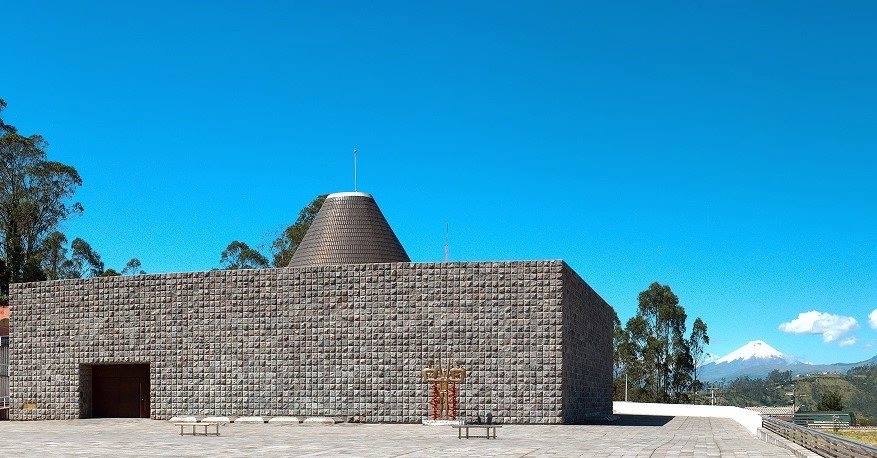
Guayasamín’s former Residence
High above the Chapel, you’ll find Guayasamín’s former residence. When you walk up though, you first encounter a perfect replica of a Maya-stele of Copán, Honduras
- A personal favorite, because of my fascination with the Maya-civilization. See About me & The #1 Maya site of Copán.
Before you arrive at the beautiful house, you pass a remarkable pine tree. The Árbol de la Vida/Tree of Life is embellished with all kinds of colourful decorations. Below this tree rest Oswaldo Guayasamín’s ashes (Together with those of his old friend, the Ecuadorian writer Jorge Enrique Adoum (1926-2009)).
The former residence is open to the public & filled with more of his work, his art collections, as well as hundreds of Pre-Colombian artefacts. The house is kept like it was when the legendary painter was still alive.
One of the most impressive rooms for me was his former studio. Enormous, with lots of light and even some unfinished works of the painter.

All in all, an inspiring place with amazing views of the northern part of Quito & Mt. Pichincha. Highly recommended, as a part of getting to know Ecuador, its culture & history.
- For more info, go to: Capilla del Hombre.
If you like you can arrange a guided tour (English or Spanish), through the following link: Capilla del hombre tickets & guided tour
Organised tours in & around Quito
Introduction
Below you’ll find a summary of guided tours & attractions you may consider booking during your visit to Quito. All within the city itself & provided by GetYourGuide. Just click on the name…. but wait wait…
Let me first ask you: Have you ever heard of GetYourGuide?
Booking Platform GetYourGuide
In case you’ve already worked with GetYourGuide, just skip the following segment & continue with the tours in & around Quito. If not, here’s a short introduction.
- GetYourGuide is an experienced European Booking Platform (HQ Berlin, Germany with field offices in 16 other countries).
- Yearly they sell millions of well organised, relaxing travel experiences all around the world.
- In every country they work with professional local guides.
If you click on a link provided below you’ll get a detailed explanation of every tour/activity & its cost. Before you decide to purchase a certain tour/activity I’d like you to know:
- GetYourGuide generally offers several options for a certain tour/activity.
- Best price guarantee.
- Saving you money & time (skipping the line).
- Has a free & easy cancellation/refund policy.
- Besides a description of a certain tour/activity GYG provides honest reviews of clients.
- If you purchase a certain tour/activity a small commission will go to me (paid by GYG, not by you).
Organised Tours within the City of Quito
So after this short introduction I hope I can with peace of mind say…
Click on the names to learn more:
Experience Quito by night aboard an old tram (replica, see below). Admiring the city’s illuminated monuments & churches. Get a spectacular view of the colonial center from high above & learn about the city’s urban legends of the past.
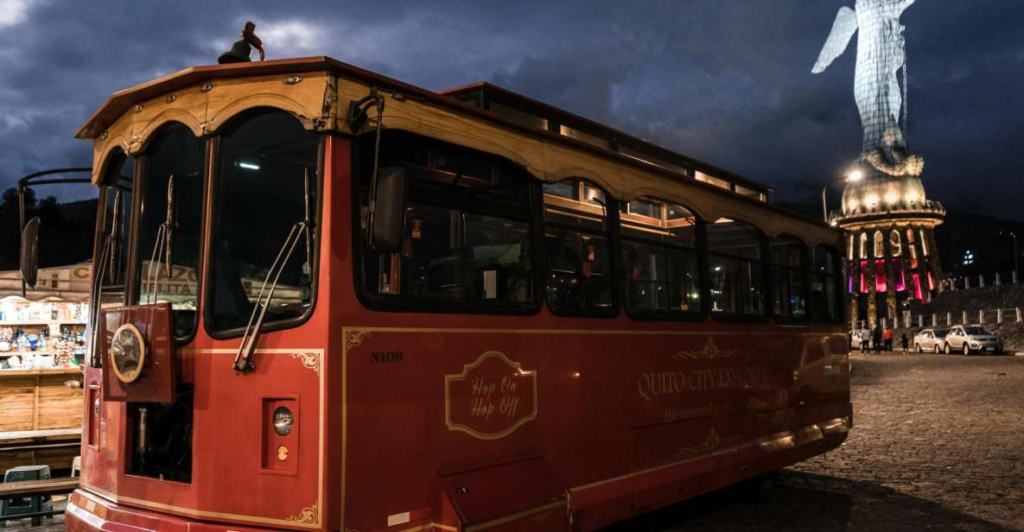
Explore the colonial part of Quito. First in the above mentioned tram, followed by a walking tour along the most interesting, historic monuments.
This walking tour (4 hours, with a small group) takes you to the highlights of Colonial Quito. Including the central market where you can drink a traditional “canelazo” and taste local products, like exotic fruit & chocolate.
After visiting the highlights of the old town, a cable car brings you up to around 4000m/ 13120ft for some spectacular views of Quito & surroundings. Followed by a guided hike to the summit of Mt.Pichincha at 4700m/ 15420ft.
The getyour tour as above, but instead of hiking you can enjoy a beautiful 2 to 3-hour ride on horseback on the flanks of Mt.Pichincha.
The Cable Car carries you up to 4000m/ 13120ft on the flanks of Mt.Pichincha for some breathtaking views of Quito. Followed by a private tour of the colonial part of Quito.






Quito Food Tours:
Enjoy a gastronomic tour through central & northern Quito. A culinary journey along some favourite eating spots & markets in town. Tasting unique food & new flavours.
This tour combines history & food. Experience the many monumental highlights Quito colonial has to offer, meanwhile learning & tasting the best local food, fruit, chocolate, and coffee at the local market & cafeterias.
Guided by one of Ecuador’s top chefs, on this tour you’ll explore the Floresta neighbourhood. The culinary center of modern Quito. Tasting wine, cocktails, and different desserts, in which the famous Ecuadorian cacao is the main ingredient.
This private tour (6-hours) starts with a visit to the local market to buy the best traditional ingredients. Products which afterwards will be used by you – together with a local chef – to prepare several tasty, traditional Ecuadorian dishes.

This tour first takes you along the highlights of the most impressive historic center of South America. Followed by a craft beer (“cerveza artesanal”) tour that teaches you about the art of making beer the old fashioned way.
Attractions to visit outside of Quito
Zoo of Quito in Guayllabamba
North of the capital you’ll find the Quito Zoo. Mainly filled with animals that live within the boundaries of Ecuador. Like the Andean bear & the Condor (national symbol of Ecuador). But also some animals from other continents, like the African Lion & Australian kangaroo.
- You’ll pass the zoo on your way to Otavalo. Ideal for a stop. Alternatively, you can visit the Condor Park near Otavalo. To see the Condor & many other birds of prey.
Mitad del Mundo
The most popular attraction within the boundaries of the Distrito Metropolitano de Quito is the Middle of the World monument – La Mitad del Mundo.
Rather than a monument, it’s a small town: the Middle of the World City.
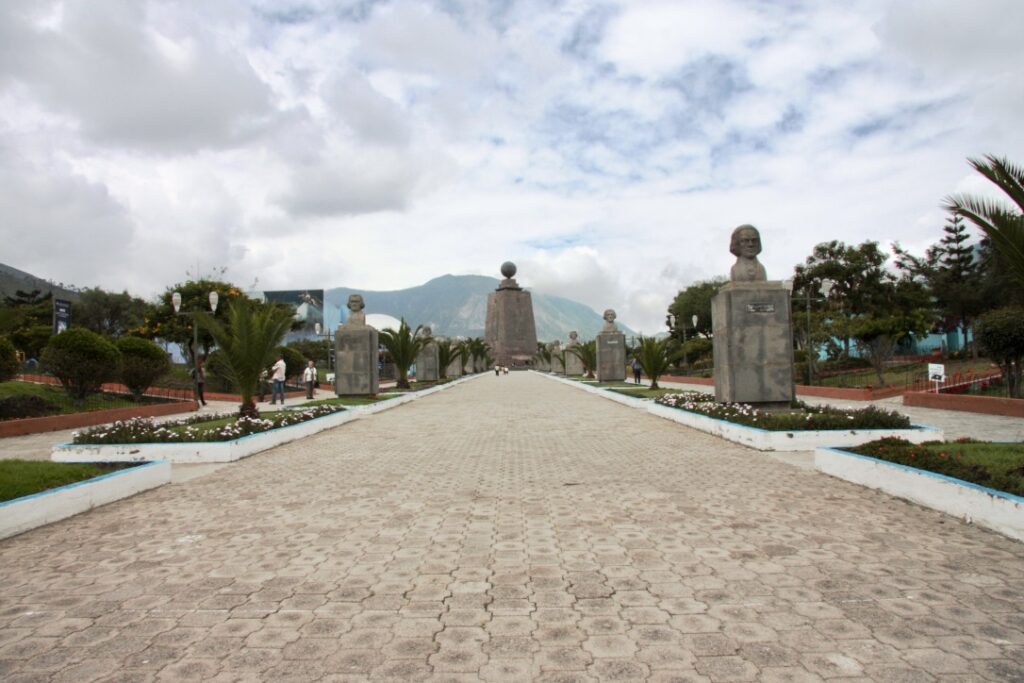
The central monument itself houses an interesting Ethnological museum. Around the monument you’ll find several other attractions – like a Planetarium & Quito Colonial in Miniature – many souvenir shops, restaurants & cafeterias.
The monument was actually built to commemorate the French Geodesic Mission. It was inaugurated in 1982.
- Many people think the French mission was responsible for the building of the monument, but that isn’t true. They probably weren’t in the neighbourhood either. To learn more, go to: Intro to the French Geodesic Mission.

- Besides that, the monument is a bit off the Equatorial line. Modern day measurements place the actual line 240m/ 790ft to the north.
How to get to Mitad del Mundo
By bus
There are public buses heading to the Mitad del Mundo (located in San Antonio de Pichincha). Ask your hotel where the nearest bus stop to Mitad del Mundo is.
- Be aware though that these buses – as they cross the whole length of the northern part of the capital & make many stops along the way – take a while to arrive at the monument. An interesting ride though, if you have the time.
By taxi
Another option of course is to arrange a taxi. Preferably one way, but if you decide to ask your driver to wait, negotiate a price & pay him/her at the end.
By organised tour
Alternatively, you can book a tour (in group or private). One that exclusively gets you to the monument or combines your visit with other attractions in Quito itself, or near the Equator.
Like for example the impressive Pululahua crater, a little to the north of the monument. Or the Intiñan Site Museum, next to the Mitad del Mundo. A museum full of fun games connected with the unique location you’re on – the Equator.

- Actually the Intiñan Museum is located a little bit closer to the true Equator.
To learn more, go to: Tours to the Mitad del Mundo
- If you don’t see a chance to visit the Mitad del Mundo monument near Quito, there’s a good alternative near Cayambe (half an hour from Otavalo). Smaller, but interesting (and actually located exactly on the Equator). To get an idea: click on: Mitad del Mundo, Cayambe.

Organised day-trips from Quito … but first a warning!
Besides the (half-a) day-tour to Mitad del Mundo – which is still within the Metropolitan district – there are several other interesting day-trips to make from Quito.
Like, for example, the Cotopaxi National Park, the Mindo Cloud Forest, the Otavalo indigenous market, and others. I will describe these one by one below, but…
- WARNING! All these tourist places deserve more time. If you can stay there a few days/nights I’d highly recommend you to do so. Staying overnight near the impressive Mt. Cotopaxi is unforgettable. Mindo is good for at least 2 full days or more. As is Otavalo.
Worse – being myself the owner of a small hotel & restaurant in Otavalo – it feels stupid to promote a day tour to Otavalo. Advertising on this travel blog the so many Things to do around this Andean market town.
Unless…
Well, …. I know not all travellers have all the time in the world to stay a few nights in every tourist place. Many US citizens have only 2 weeks to see it all, including a few days on the Galápagos Islands. For them & others the best option to do as much as possible is a quick visit to Otavalo & other places around Quito.
The main reason for me to describe & promote the most popular day-trips. Not after this special warning!
The most popular day-trips
Click on the names to learn more:
- All tours/activities provided by GetYourGuide. A European Booking Platform I introduced to you in an earlier segment of this post. If you missed it, here’s a link: Introduction to GetYourGuide.
The most popular day-tour from Quito by far leads you to the Cotopaxi National Park. Mainly because it’s relatively nearby. You’ll not only get glimpses of one of the most impressive snow-capped volcanoes of Ecuador, but also of the natural area around. Like the Lagoon of Limpiopungo & a hike up to the Jose Ribas shelter.
- If you like you can even combine the Cotopaxi National Park with a visit to the magical Crater lake of Quilotoa. A long day-trip from Quito, but … I guarantee, an unforgettable one.To learn more, go to: Cotopaxi & Quilotoa tour.

If you want to change the scenery for a day, book a day-trip to the Mindo Cloud Forest Reserve. This tour includes a visit to a hummingbird sanctuary, a hike to the waterfalls, zip lining, rappelling, tubing, a coffee or chocolate tour.

On this tour you first head out to Otavalo where you’ll have time t0 explore the biggest indigenous market of South America. Followed by a visit to nearby Pueblo Mágico/ Magical Village of Cotacachi – known for its fine leather work. Finally ending up at the unique Cuicocha Crater lake, before returning to Quito.
Within a hour’s drive from Quito you’ll find the paradisiacal hot springs of Papallacta. Ideal place to fully relax for a few hours. That is, after a short, beautiful hike near the baths, which is included in this tour.

And some more full-day-tours from Quito
Pure high altitude nature is what you’ll get on this trip out of Quito. Living space of the mighty Condor & many other birds of prey. As well as some mammals, like deer, foxes, wild rabbits, and if lucky, sometimes even the Andean bear. Besides that you’ll visit the snow-capped Mt. Antisana, 4th highest in the country.
Enjoy a private day-trip to Baños de Agua Santa. A unique place on the border of the Andean highlands & the Amazon jungle. After a visit to the friendly town of Baños itself you’ll visit some spectacular waterfalls on the way down to the Amazonía, like the Pailón del Diablo/ The Devil’s Cauldron (see photo below).
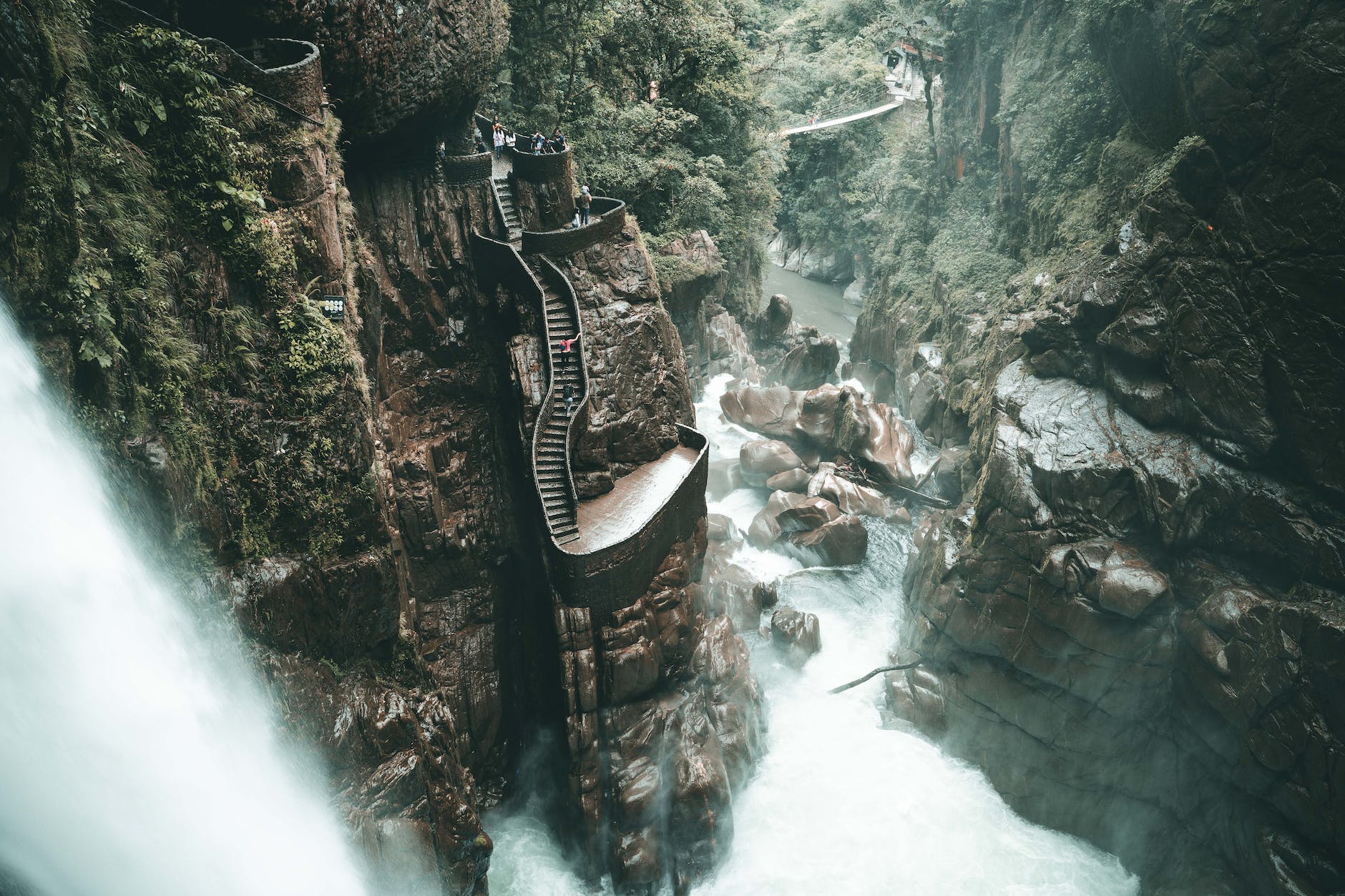
(Photo by Shad Meeg on Pexels.com).
So, is Quito …..worth a visit? Yes or No.
Yes, sure. Definitely!
Quito has a lot of worthwhile attractions. A variety of Things to Do that may interest you & are presented to you one by one in this blogpost. That is, a good selection of them.
The only reason not to go is, when you don’t like BIG cities. Big Cities are characterised by lots of people, too much traffic, smog & petty crime.
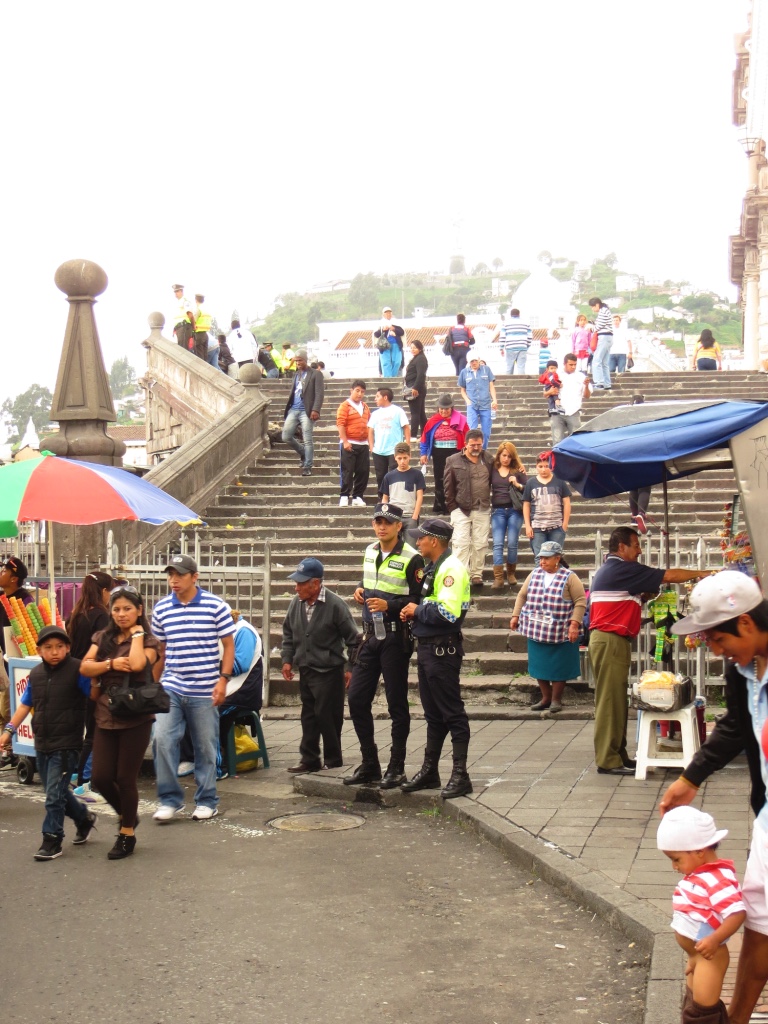
- For all the latest news on Ecuador, join my Visit Ecuador Facebook Group.
.
For an overview of all travel posts of my blog, go to: the Home Page.
- Final message, for fellow travel writers & bloggers: TravelPayOuts is a global integrated affiliate program focused exclusively on travel offers. If it works for me, it will probably work for you too: TravelPayOuts.


Comments
One response to “Should you visit Quito, Ecuador? Yes or … better No?”
[…] Question #2: Should you visit Quito, Yes or … better No? […]